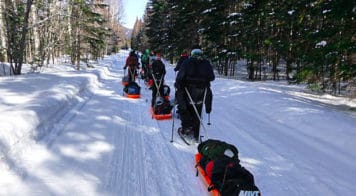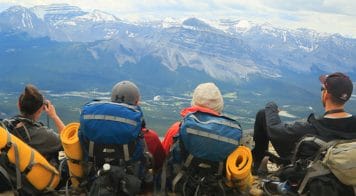Wildfire Policy
UPDATE regarding 2023 Wildfires
Canada is experiencing record high wildfire seasons – 2023 marking one of the largest wildfire seasons on record. Data suggests that this trend is expected to continue in future years. OBC’s National Risk and Safety Team monitors the wildfire and smoke situation daily to ensure that the wellbeing of our participants is foremost in our planning.
The following is a summary of the steps OBC takes to mitigate the risk of wildfire and wildfire smoke on our courses. On a daily basis throughout the wildfire season, we monitor:
- NASA/FIRMS Satellite Imagery (active fires and fire hazard forecast)
● Provincial wildfire maps (active fires and fire hazard forecast)
● Wildfire smoke forecast
● Regional short- and long-term weather forecasts (rain, humidity, wind)
● Provincial and Government of Canada air quality advisories
● Provincial directives such as fire bans and Off Road Vehicle bans
● Provincial directives from wildfire incident command teams regarding backcountry
travel
We take a conservative approach to wildfire risk. We will relocate a group to an alternate area
if the risk is deemed too high. If no suitable alternate area is available, we may cancel or
reschedule the program.
If a course is in a concerning position regarding wildfire or smoke, we will communicate with the parents/guardians of students on that course.
● We monitor the Air Quality Health Index (AQHI) and Air Quality Index (AQI) throughout the program. If the level of concern is rated a “Very High Risk” for three consecutive days we will strongly consider canceling or rescheduling the program.
- In the past it has been difficult to obtain accurate AQHI readings for our backcountry
courses, as the measuring devices for these systems are based in urban areas.
To remedy this, in 2023 we ran a pilot system where instructors carried
portable air quality measurement devices on our Rocky Mountain courses. If the
measured AQI in the field is “Hazardous”, we will strongly consider relocating or
canceling the program. - Each group that travels in the backcountry has two modes of communication: A satellite phone and an In Reach device (2-way satellite texting and tracking device). These devices allow us to track the exact location of each program and share relevant updates with them. Instructors check in with our in-town support staff at least twice per day via these systems.
- As 2024 is forecasted to be a bad wildfire smoke year in Canada, we encourage potential
students with pre-existing lung conditions (i.e., asthma, cardiovascular conditions, or
lung damage due to COVID-19) to speak with their doctor about participation in the
course.
Outward Bound Canada’s Wildfire Smoke Policy
Climate change is increasing the frequency and severity of wildfires around the world, with Canada being particularly vulnerable to this hazard. Due to spending long periods of time outdoors, Outward Bound Canada (OBC) participants and staff are increasingly impacted.
Who is At Risk?
Although nobody is immune to the effects of wildfire smoke, some people will be affected more than others due to pre-existing health conditions, such as respiratory illnesses, cardiovascular conditions, and chronic illnesses. People recovering from COVID-19 may also be more susceptible to wildfire smoke due to compromised lung function.
Additionally, people who work in the outdoors and/or partake in strenuous outdoor activities are considered more vulnerable to wildfire smoke. For this reason, OBC uses a conservative approach to managing these risks.
Tools Used to Assess Risk
OBC uses the Air Quality Health Index (AQHI) and the Air Quality Index (AQI) to determine the suitability of a specific location for outdoor programs. These tools are widely used to assess the risk level of smoke generated by wildfires.
The Air Quality Index
The Air Quality Index (AQI) is a tool used by many government agencies to communicate to the public how polluted the air is and how polluted it may become over a 48-hour period.
Think of the AQI as a yardstick that runs from 0 to 500. The higher the AQI value, the greater the level of air pollution and the greater the health concern. For example, an AQI value of 50 or below represents good air quality, while an AQI value over 300 represents hazardous air quality. For each pollutant an AQI value of 100 generally corresponds to an ambient air concentration that equals the level of the short-term national ambient air quality standard for protection of public health.
The Federal Government provides public guidance in relation to outdoor activities, based on the risk level determined by the AQHI and the impacted population.
AQI values at or below 100 are generally thought of as satisfactory. When AQI values are above 100, air quality is unhealthy: at first for certain sensitive groups of people, then for everyone as AQI values get higher. The AQI is divided into six categories. Each category corresponds to a different level of health concern. Each category also has a specific colour. The colour makes it easy for people to quickly determine whether air quality is reaching unhealthy levels in their communities.

The Air Quality Health Index
The AQHI is calculated by determining the presence of common pollutants in the air: Ozone at the ground level, Particulate Matter and Nitrogen Dioxide.
The AQHI Scale:

The Federal Government provides public guidance in relation to outdoor activities, based on the risk level determined by the AQHI and the impacted population:
Low Risk (1-3): Enjoy outdoor activities as usual.
Moderate Risk (4-6): Consider reducing or rescheduling strenuous outdoor activities if experiencing symptoms.
High Risk (7-10): Reduce or reschedule strenuous outdoor activities
Very High Risk (10+): Avoid strenuous activities outdoors
Determinants of Course Changes
OBC monitors the AQHI and AQI surrounding its course locations to determine the appropriate response. If, prior to a program, the AQHI is determined to be:
Low Risk: The course will take place as scheduled.
Moderate Risk: The course will take place as scheduled. Additional consideration will be placed into the route to facilitate reducing physical activity if participants develop symptoms associated with smoke inhalation.
High Risk: Participants will be contacted to be made aware of the heightened risks of wildfire smoke during their course. Course logistics will be reviewed including the location of the program and the intended route. If logistically possible, the program will be relocated or the distance travelled during the course will be reduced to avoid ongoing strenuous activity.
Very High Risk: The course will be moved to a new location, rescheduled, or canceled.
Please note that, even in an area that is relatively close to wildfire, the air quality can vary considerably over the space of several days. It is common for an area to have an AQHI of 10 one day, and 3 the next day. For this reason, we monitor course areas daily, and make determinations based on multi-day trends.
For example, if the forecast is either an AQHI 10+ or AQI 301+, but most of the days on course are in the AQHI 3 to 5 range/ AQI 150, we are unlikely to cancel or reschedule that course. If, however, the forecast is for three or more days of AQHI 10+ or AQI 301+, we will strongly consider cancelling or rescheduling that course.
Communicating Risks with Cohorts who are in the Field
Each group that travels in the backcountry has 2 modes of communication: A satellite phone and an In Reach device (2-way satellite texting and tracking device). These devices allow us to track the exact location of each program and share relevant updates with them.
In the past it has been difficult to obtain accurate AQHI/AQI readings for our backcountry courses, as the measuring devices for these systems are based in urban areas. Therefore, each cohort’s experience with wildfire smoke may vary from the reported ratings. Frequent communication with cohorts allows us to adequately monitor the risk of wildfire smoke and respond quickly and effectively. If a course experiences an estimated AQHI of 10+ or AQI of 301+ for 24 hrs or longer, we will either remove that course from the field or relocate them to an area with better air quality.
In an effort to obtain more accurate air quality measurements in the field, we are running a pilot system of having instructors carry portable air quality measurement devices on our Rocky Mountain courses in 2023. Data generated from these devices will be collated and used to inform our policies moving forward.
If you have any questions about OBC’s Wildfire Policy, please contact us at info@outwardbound.ca.






